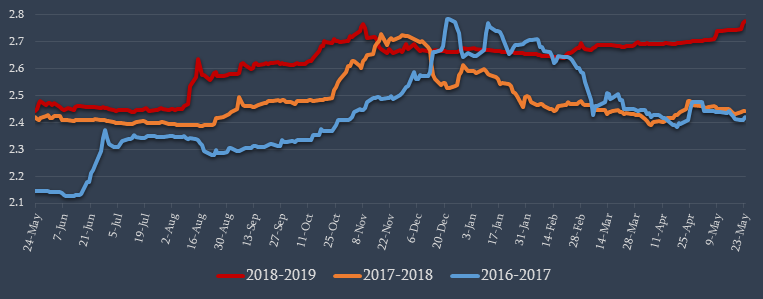Resume: Since 1 January 2019, the lowest GEL to USD exchange rate was on 19 February at 2.6404 whilst the highest one at 2.7756 was registered on 23 May. The relatively discernible trend of depreciation of the GEL exchange rate started on 8 May and the value of USD 1 increased by 2.48% from 2.7083 to 2.7756 in a period of two weeks (that is, the GEL exchange rate depreciated).
The depreciation of the national currency is not on a scale to cause economic problems although the GEL depreciation will make debt service more expensive for individuals with income in GEL and obligations in USD. In this part, the Minister of Finance’s claim about the importance of reducing dollarization (for instance, loan dollarization) is relevant, with a difference of opinion only concerning the steps needed to achieve the aim.
In regard to the causes behind the current GEL depreciation, it is important to know about the changes in currency flows in order to shed some light on the changes in the currency exchange rate in a specific short-term period. Comprehensive information vis-à-vis the country’s currency inflows and outflows is given in the balance of payments although this information is not yet available. Data about certain components (for instance, foreign trade, remittances, etc.) of the balance of payments are published sooner although the aforementioned data are not available given the fact that the current month has not yet come to an end. Therefore, only those bodies which have access to information in real time (the National Bank, the government’s economic team) are able to make a complete analysis.
An external factor – the difficult economic situation in Turkey – which is said to be affecting the GEL exchange rate is indeed one of the reasons for the GEL depreciation. This is because Turkey is one of Georgia’s main trade partners and when the situation deteriorates there, this is also reflected in Georgia. However, it is currently impossible to assert whether or not the external factor alone is the only or the main factor spurring on the depreciation of the exchange rate owing to the current unavailability of respective data.
Therefore, FactCheck leave’s the Minister of Finance’s statement without a verdict and will return to a comprehensive analysis of the topic after the respective statistical data are published.
Analysis
Yet another depreciation of the GEL to USD exchange rate has emerged as one of today’s pressing issues. At the beginning of May, USD 1 equalled GEL 2.7 whilst the current USD to GEL exchange rate is at 2.78. The Minister of Finance of Georgia, Ivane Machavariani, stated that the changes are related to external factors, including the depreciation of TRY, and emphasised the importance of de-dollarization in terms of the reduction of currency risks for the population.
Georgia’s national currency has a floating exchange rate which means that the rate is determined in line with supply and demand at the currency market and the National Bank does not interfere in this process to make corrections in the exchange rate. The only exception is when changes in the exchange rate are large enough to evoke inflation.
Changes in the currency exchange rate, corresponding to the unfolding processes in the economy, are part of a natural process and to some extent bear a regulatory effect. With the exception of a short-term substantial deviation from the trend, the artificial limitation of changes in the exchange rate is almost impossible and also undesirable given the expected outcomes. In the case of an import-dependent country such as Georgia, one of the main dangers caused by the depreciation of the national currency is to potentially evoke inflation (rising prices on consumer goods). As of April, the annual inflation rate (increase in price level) is 4.1% and exceeds the targeted inflation figure (3%) by 1.1 percentage points. If a further depreciation of GEL (or any other factor affecting inflation) will be of a scale to threaten the stability of price levels in the country, the National Bank will have to step in and impose a stricter policy to retain the level of prices within the margins of the targeted figure which will negatively affect economic growth (at the expense of price stability). However, at this stage, it is early to speak about this scenario.
Graph 1: Changes of GEL to USD Exchange Rate

Source: National Bank of Georgia
The latest relatively discernible process of GEL depreciation started on 8 May and the change in a two-week period constituted 2.48%. As illustrated by the graph, this year differed from the previous periods by a relative currency stability. A substantial fluctuation of the currency exchange rate is rather detrimental for the economy – the frequent alteration of the currency exchange rate growth and decline trends are what stipulate the growth of currency risks.
Not only the economic but the social aspect of changes in the currency exchange rate also need to be taken into account. Even though the currency depreciation is not on a scale to cause economic problems, it can be said that debt service for individuals with their income in GEL and obligations in USD has become proportionally expensive. In this part, the Minister of Finance’s claim about the importance of reducing dollarization (for instance, loan dollarization) is relevant.
In regard to the reasons behind the changes in the exchange rate, the GEL exchange rate expressesa certain value of the national currency denominated in the national currency of another country. If the GEL supply and demand vis-à-vis USD is high, the GEL exchange rate depreciates. If there is a high demand on GEL and a large supply of USD, the GEL exchange rate appreciates. The volume (supply) of GEL at the market is largely affected by the National Bank’s monetary policy and partially by the government’s fiscal policy. USD supply depends on multiple factors (foreign trade, foreign investments, remittances, change in foreign debt, etc.). Apart from real factors, the expectations of market stakeholders also affect currency supply and demand. If market participants expect a depreciation of a certain currency exchange rate in the nearest future, this expectation changes economic behaviour the same day and the expectation is reflected in an immediate depreciation of a currency.
Of additional note is that in order to clarify the changes in the currency exchange rate in a specific short-term period, it is important to know about the changes in currency flows. The quarterly or yearly aggregated data do not provide the necessary information in this regard and only allow the possibility to make a general assessment. Comprehensive information in regard to currency inflows and outflows in the country is given in the balance of payments. However, this information is published with a delay and leaves room for only a post-factum analysis of the situation. Data about certain components (for instance, foreign trade, remittances, etc.) of the balance of payments are published sooner although the aforementioned data are not available given that the current month has not yet come to an end. Therefore, only those bodies which have access to information in real time (the National Bank, the government’s economic team) are able to make a complete analysis.
The external factor – the difficult economic situation in Turkey – which is said to be affecting the GEL exchange rate is indeed one of the reasons which possibly affected the GEL depreciation. This is because Turkey is one of Georgia’s main trade partners. However, it is currently impossible to assert whether or not the external factor alone is the only or the main factor spurring on the depreciation of the exchange rate because respective data still remain unavailable.


















